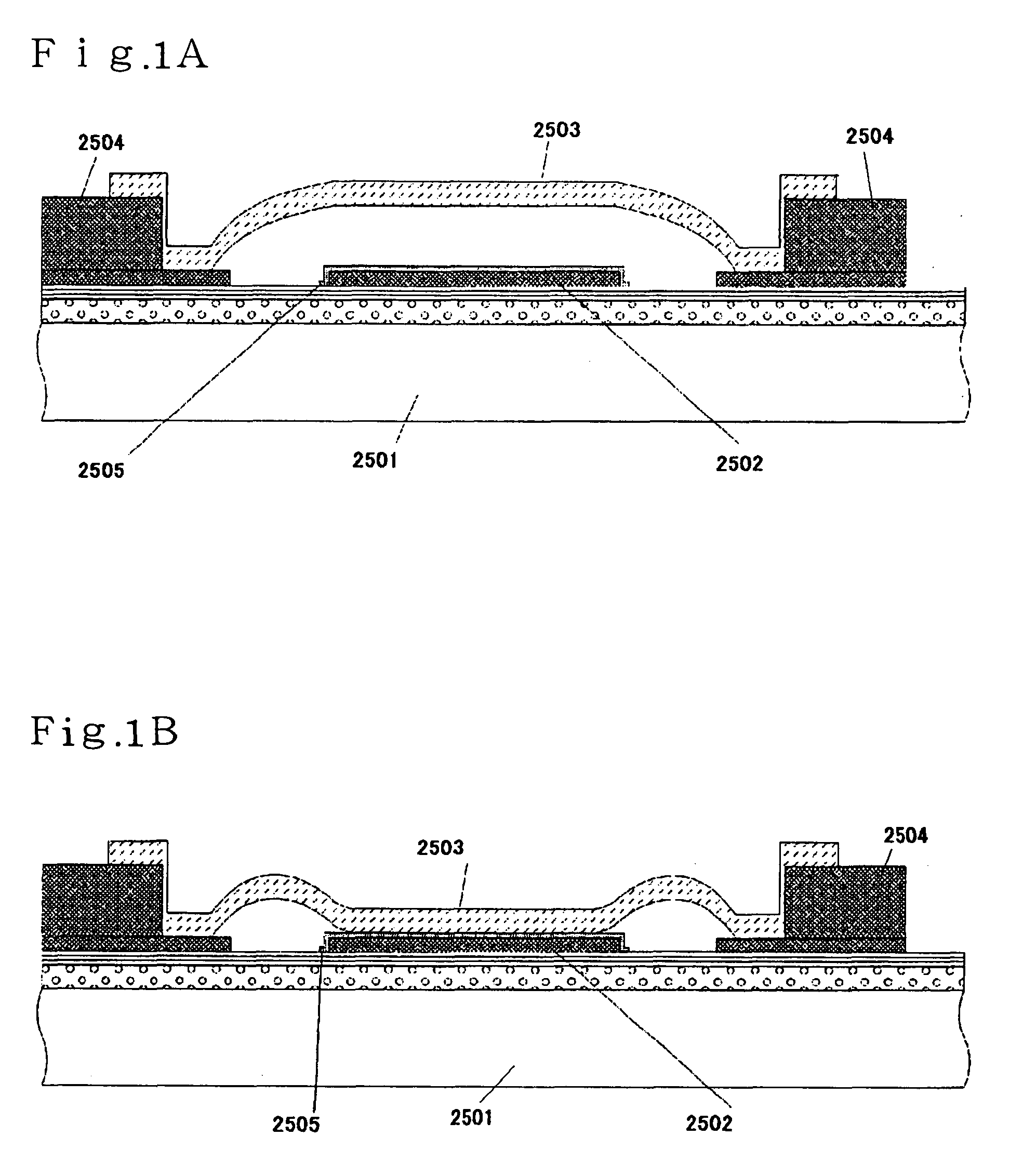Switch and method for manufacturing the same
a technology of switching speed and manufacturing method, applied in the field of switches, can solve the problems of reducing operation speed, complicated fabrication process, and difficulty in increasing switching speed, and achieve the effects of reducing structure height, high speed, and ensuring signal transmission efficiency
- Summary
- Abstract
- Description
- Claims
- Application Information
AI Technical Summary
Benefits of technology
Problems solved by technology
Method used
Image
Examples
first exemplary embodiment
1. First Exemplary Embodiment
[0043]FIG. 2 is a perspective view of a switch in embodiment 1 of the present invention. This is structured by a movable electrode 103, a movable electrode driving fixed electrodes 104 and a signal transmitting fixed electrode 105, that are formed on a high resistive silicon substrate 101 through a silicon oxide film 102. The movable electrode 103 has a plurality of convex parts 107 in side surfaces thereof. In this embodiment 1, the convex parts 107 are assumed to be made all in the same form for convenience sake, and arranged at a periodic interval. Concave parts are formed between one convex part 107 and the adjacent convex part 107. The concave parts are also arranged at a periodic interval. The movable electrode driving fixed electrode 104 also has a plurality of convex parts 108 arranged, in its side surface, correspondingly to and surrounded by the concave parts of between the convex parts 107 on the side surface of the movable electrode. The conc...
second exemplary embodiment
2. Second Exemplary Embodiment
[0056]The force acted upon the electrodes having a combination of convex and concave parts is described, e.g. in IEEE MEMS 2002 Tech. Dig., p532, 2002. In the case of displacement-z, the force acted in a z-direction is given by Equation 4.
Fz=∂(CV2 / 2) / ∂z Equation 4
[0057]In equation 4, V is the application voltage to the electrode, C is the capacitance formed between the electrodes, and z is given as a displacement. From Equation 4, it can be seen that, even where there is no capacitance change formed between the electrodes when there is a displacement change in the z-direction, an electrostatic force does not takes place. Accordingly, in the case that, for example, the movable electrode driving fixed electrode 104 is greater than the movable electrode 103 in thickness as shown in FIG. 9, the capacitance region 901 in the movable electrode driving fixed electrode 104 and movable electrode 103 is not changed in area by a somewhat movement of the movable e...
third exemplary embodiment
3. Third Exemplary Embodiment
[0060]As shown in FIG. 10A, the convex part 1004 on the side surface of the movable electrode 1002 and the concave part 1005 of the movable electrode driving fixed electrode 1001 have a predetermined gap 1003 having an even distance d between them. However, in the case the movable electrode 1002 and the movable electrode driving fixed electrode 1001 are formed through the use of different masks, when a misfit occurs between the mask for forming a movable electrode and the mask for forming a movable electrode driving fixed electrode, the result is as shown in FIG. 10B. Namely, the gap on one side between the convex part 1004 on the side surface of the movable electrode and the concave part 1005 of the movable electrode driving fixed electrode 1001 is narrowed into d−e, i.e. a narrow gap 1013. The gap between the concave part 1005 and the concave part 1005 on opposite side is broadened into d+e, i.e. a wide gap 1014. Namely, FIG. 10B shows a relationship b...
PUM
 Login to View More
Login to View More Abstract
Description
Claims
Application Information
 Login to View More
Login to View More - R&D
- Intellectual Property
- Life Sciences
- Materials
- Tech Scout
- Unparalleled Data Quality
- Higher Quality Content
- 60% Fewer Hallucinations
Browse by: Latest US Patents, China's latest patents, Technical Efficacy Thesaurus, Application Domain, Technology Topic, Popular Technical Reports.
© 2025 PatSnap. All rights reserved.Legal|Privacy policy|Modern Slavery Act Transparency Statement|Sitemap|About US| Contact US: help@patsnap.com



